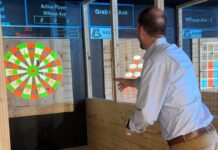The 20,000-square-foot space enables the cleantech startup to hire additional team members, tackle larger projects and revolutionize the carbon management industry in Louisville, TN
SkyNano, a science-based technology company focused on commercializing a free-market solution to carbon pollution, has moved into a into a 20,000-square-foot facility at 3255 Wrights Ferry Road in Louisville, Tennessee.
There was a ribbon-cutting ceremony March 20 where SkyNano offered facility tours of the state-of-the-art facility that marks a significant expansion.
SkyNano is expanding its carbon management and sustainable technology to hire additional employees, increase production capacity and “further develop its groundbreaking technology, and meet the growing demand for carbon-negative materials.”
“I am thrilled to move into our new facility in Louisville, Tennessee. SkyNano is a Tennessee-grown company, so it brings me tremendous personal and professional satisfaction to take this next step in our backyard,” said Anna Douglas, Co-Founder and chief executive officer of SkyNano. “This move would not have been possible without the hard work and innovative thinking of the SkyNano team. I am grateful for every team member and look forward to reaching new heights in the carbon management industry in 2024 and beyond.”
The company was created in 2017, originally located at Vanderbilt University in the Innovation Crossroads at Oak Ridge National Laboratory and Spark Innovation Center, it soon moved in 2022 into its first true location in Knoxville.
“The past seven years have been a whirlwind of growth for SkyNano,” said Cary Pint, Co-Founder and Chief Technology Officer of SkyNano. “This larger, customized facility is the natural next step for SkyNano. We continue to be committed to reshaping and revolutionizing the carbon management industry.”
Speakers and showcases included:
- Tom Rogers, President and CEO, University of Tennessee Research Park
- Lindsey Cox, CEO, Launch Tennessee
- Deborah Crawford, Vice Chancellor of Research, University of Tennessee
- Joe Hoagland, Vice President of Enterprise Relations and Innovation, Tennessee Valley Authority
- Susan Hubbard, Deputy Laboratory Director for Science and Technology, Oak Ridge National Laboratory
- Chris Saldaña, Director of the Advanced Materials and Manufacturing Technologies Office, United States Department of Energy
- At the event, SkyNano showcased its technology scale-up with its Generation 3 device – 200 gram-multi-walled carbon nanotube (MWCNT) per hour and continuous operation for carbon emission uptake. Additionally, the startup highlighted several demonstration projects, including:
- Low-embodied carbon building materials: SkyNano, Endeavor Composites and the University of Tennessee, Knoxville, are working to develop a low-embodied carbon building material panel for use in non-structural building material applications.
- High-performance lithium-ion batteries: SkyNano and Eonix are developing a high-performance MWCNT/silicon-based electrode structure for long-lifetime lithium-ion battery anodes. Paired with Eonix’s novel electrolyte screening technology, we’ve demonstrated significant improvement in cycle life compared to silicon anodes without MWCNTs and stabilized electrolytes.
- Low-embodied carbon cementitious composites: SkyNano, in partnership with Dr. Hongyu Nick Zhou’s laboratory at UTK, is developing a novel cementitious composite for defense applications in 3D-printed concrete. The ability to 3D print a structure in extreme or dangerous environments helps improve warfighter capabilities and safety. With SkyNano MWCNTs, we’re working towards in-situ defect detection to improve the quality of prints and the functional strength and properties such as EMI shielding, lightning strike protection, etc.
- High-performance, low-embodied carbon composites: The Navy is invested in lowering its operational and embodied carbon across all defense activities. SkyNano, Endeavor Composites and UTK are partnering to develop sustainable, low-embodied carbon composites that don’t sacrifice the high performance required by naval applications. These are anticipated to be excellent material candidates for mass-sensitive applications such as drones and UAVs.
Image by kjpargeter on Freepik.
Copyright 2023 The Upper Cumberland Business Journal. All rights reserved. This material may not be published, broadcast, rewritten or redistributed.
Other stories you may want to check out:









